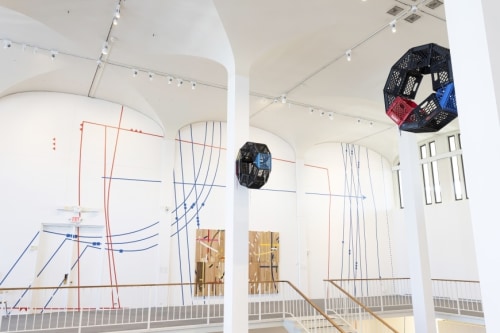
Ronny Quevedo's one-person exhibition, Ronny Quevedo: offside, at the University Art Museum at University of Albany, NY.
The institution's press release follows:
The University Art Museum is pleased to present three new exhibitions opening on January 25, 2022. In Ronny Quevedo: offside, multi-media artist Ronny Quevedo occupies the arched walls of the museum’s main galleries in a newly commissioned work, fuera de lugar (2021), comprised of diagrammatic vinyl lines that recall both dress patterns and gymnasium floors. This work is inspired by his mother’s and father’s respective careers—a seamstress and a professional soccer player. Throughout this exhibition, which includes artwork from 2012 to the present, Quevedo’s own family’s emigration from Ecuador to New York serves as a catalyst for work reflecting on socio-political issues of migration, Indigenous architecture, and communal spaces.
In fuera de lugar, gymnasium lines recall the indoor soccer leagues which for Quevedo and others who migrated to New York became places of comradery and belonging. This belonging is tempered by the title fuera de lugar, the Spanish term for “offside,” a reference to the rule in soccer that restricts a player’s movement: they are penalized for going too far when unopposed. Literally translated, it reads “out of place,” suggesting displacement; but this displacement also opens the possibility of exploring new bounds, uncharted territories, and liminal sites.
Quevedo’s second newly commissioned work, a mother’s hand (2021), references pre-Columbian platform architecture and agricultural plans, as well as present-day bleachers. Its modular quality, a grid within a grid, not only plays with the modernist exploration of the grid and modularity in the 1960s design by Edward Durell Stone of the museum within which this work is sited, but also bears witness to the much earlier exploration of the grid in pre-Columbian textiles. Moving across both space and time, a mother’s hand pays homage to both those pre-Columbian textile traditions and the manual labor of Quevedo’s mother, a seamstress whose materials inspired the dress patterns seen throughout the exhibition, gilded and endowed with a sense of the sacred. Further recentering us, Quevedo has added carbon paper drawings on four walls of the museum, oriented to the cardinal directions. Simultaneous with this new—and ancient—sense of orientation, Quevedo’s offside pays homage to the past and forms new visions of belonging for a future which, like the outcome of a game, is yet to be determined.